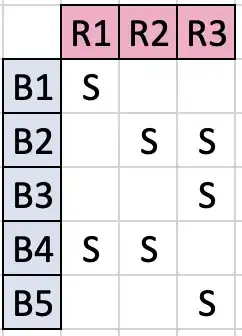There are $5\cdot3=15$ blue-red pairs and a string can be there or not there; so the number of "stringings" from $5$ nails to $3$ nails is $2^{15}$. But this includes stringings which miss nails.
Inclusion-Exclusion
Let us call the subset of stringings that do not touch the $k^\text{th}$ red nail $R_k$ and the subset of stringings that do not touch the $k^\text{th}$ blue nail $B_k$. These are the $S_k$'s of the Generalized Inclusion-Exclusion Principle.
We can sum the sizes of the intersections of $k$ of the $B$'s and $R$'s ($N(k)$ from the Generalized Inclusion-Exclusion Principle):
$$
N(k)=\sum_{j=0}^k\overset{\substack{\text{the number}\\\text{of choices}\\\text{of the $B$'s}\\\downarrow\\[3pt]\,}}{\binom{5}{j}}\overset{\substack{\text{the number}\\\text{of choices}\\\text{of the $R$'s}\\\downarrow\\[3pt]\,}}{\binom{3}{k-j}}\overbrace{2^{(5-j)(3-k+j)}\vphantom{\binom52}}^{\substack{\text{number of stringings}\\\text{given the choice of}\\\text{$B$'s and $R$'s}}}\tag1
$$
The number of stringings in $0$ of the $B$'s and $R$'s is given by the Generalized Inclusion-Exclusion Principle as
$$
\sum_{k=0}^8(-1)^kN(k)%=16081
\tag2
$$
Simplification
$$
\begin{align}
f(a,b)
&=\sum_{k}(-1)^kN(k)\tag{3a}\\
&=\sum_{j,k}(-1)^k\binom{a}{j}\binom{b}{k-j}2^{(a-j)(b-k+j)}\tag{3b}\\
&=\sum_{j,k}(-1)^{k+j}\binom{a}{j}\binom{b}{k}2^{(a-j)(b-k)}\tag{3c}\\
&=\sum_{j,k}(-1)^{a+b-k-j}\binom{a}{j}\binom{b}{k}2^{jk}\tag{3d}\\
&=\sum_{j}(-1)^{a-j}\binom{a}{j}\left(2^j-1\right)^b\tag{3e}\\
\end{align}
$$
Explanation:
$\text{(3b)}$: plug $(1)$ into $(2)$
$\text{(3c)}$: substitute $k\mapsto k+j$
$\text{(3d)}$: substitute $j\mapsto a-j$ and $k\mapsto b-k$
$\text{(3e)}$: apply the Binomial Theorem
This is symmetric in $a$ and $b$, so take $a\le b$ to reduce the number of terms.
$$
f(3,5)=\sum_{j=0}^3(-1)^{3-j}\binom{3}{j}\left(2^j-1\right)^5\tag4
$$
However, if we switch them around, we get
$$
f(5,3)=\sum_{j=0}^5(-1)^{5-j}\binom{5}{j}\left(2^j-1\right)^3\tag5
$$
the $j=5$ term of which looks more like what is mentioned in the question.
Interpretations of the Simplified Formulas
In formula$(4)$, the index $j$ term counts the number of functions from the $5$ blue nails to a nonempty $j$-subset of the $3$ red nails, i.e. $\left(2^j-1\right)^5$, times the number of such $j$-subsets, i.e. $\binom{3}{j}$.
In formula$(5)$, the index $j$ term counts the number of functions from the $3$ red nails to a nonempty $j$-subset of the $5$ blue nails, i.e. $\left(2^j-1\right)^3$, times the number of such $j$-subsets, i.e. $\binom{5}{j}$.
Thus, $(2)$, $(4)$, and $(5)$ give three different ways to solve this problem (all using inclusion-exclusion).
